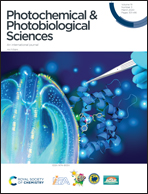|
Authors
Delcanale, Pietro; Hally, Cormac ; Nonell, Santi ; Nonell, Santi ; Bonardi, Silvia; Viappiani, Cristiano; Abbruzzetti, Stefania ; Bonardi, Silvia; Viappiani, Cristiano; Abbruzzetti, Stefania
|
Abstract
Hypericin (Hyp) is one of the most effective, naturally occurring photodynamic agents, which proved effective against a wide array of microorganisms. One limitation of its large scale application as a disinfectant is the high production cost of the pure compound. The availability of photoactive materials at a lower cost may be highly beneficial to the actual implementation of photodisinfection also at the industrial level. In this work we report the use of a lyophilized extract from Hypericum perforatum as a photosensitizing material. We show that optical absorption in the green-red region of the visible spectrum of ethanol or DMSO solutions of the lyophilized extract contains bands arising from Hyp. When excited with light in the main Hyp absorption bands, fluorescence emission and triplet state formation occur as in pure Hyp solutions. We show that ethanol or DMSO solutions of the lyophilized extract from Hypericum perforatum are highly efficient photodynamic agents against Gram-positive Staphylococcus aureus, chosen as a model. The performance is indistinguishable from that of the pure compound. Using fluorescence microscopy, we demonstrate that upon incubation of S. aureus with lyophilized extract solutions, Hyp is found on the bacterial wall, as previously reported for the pure compound.
|

WoS
Scopus
Altmetrics
  
|
|
Journal
Photochemical & Photobiological Sciences, 2020, v.19, n.3, p.324-331
|
